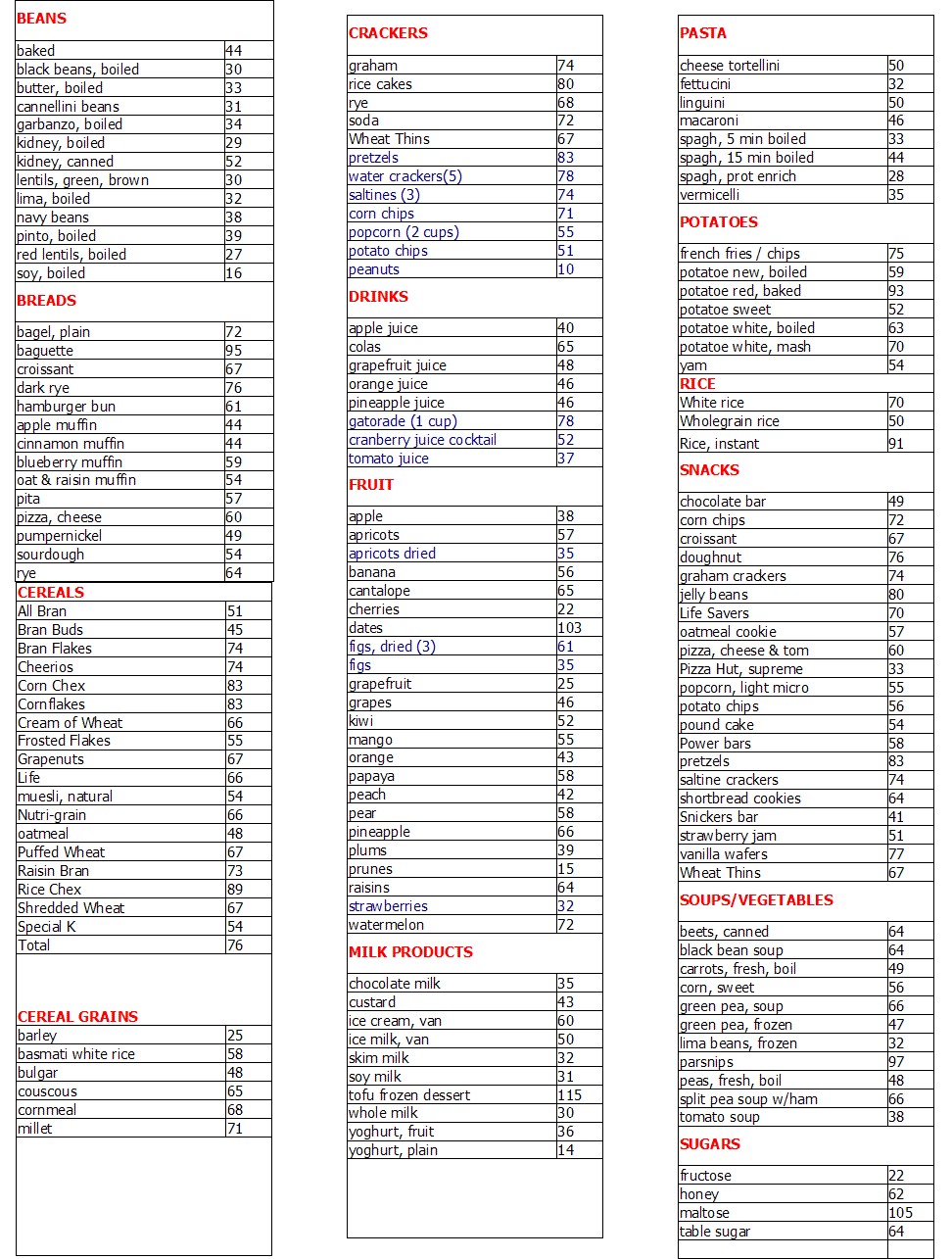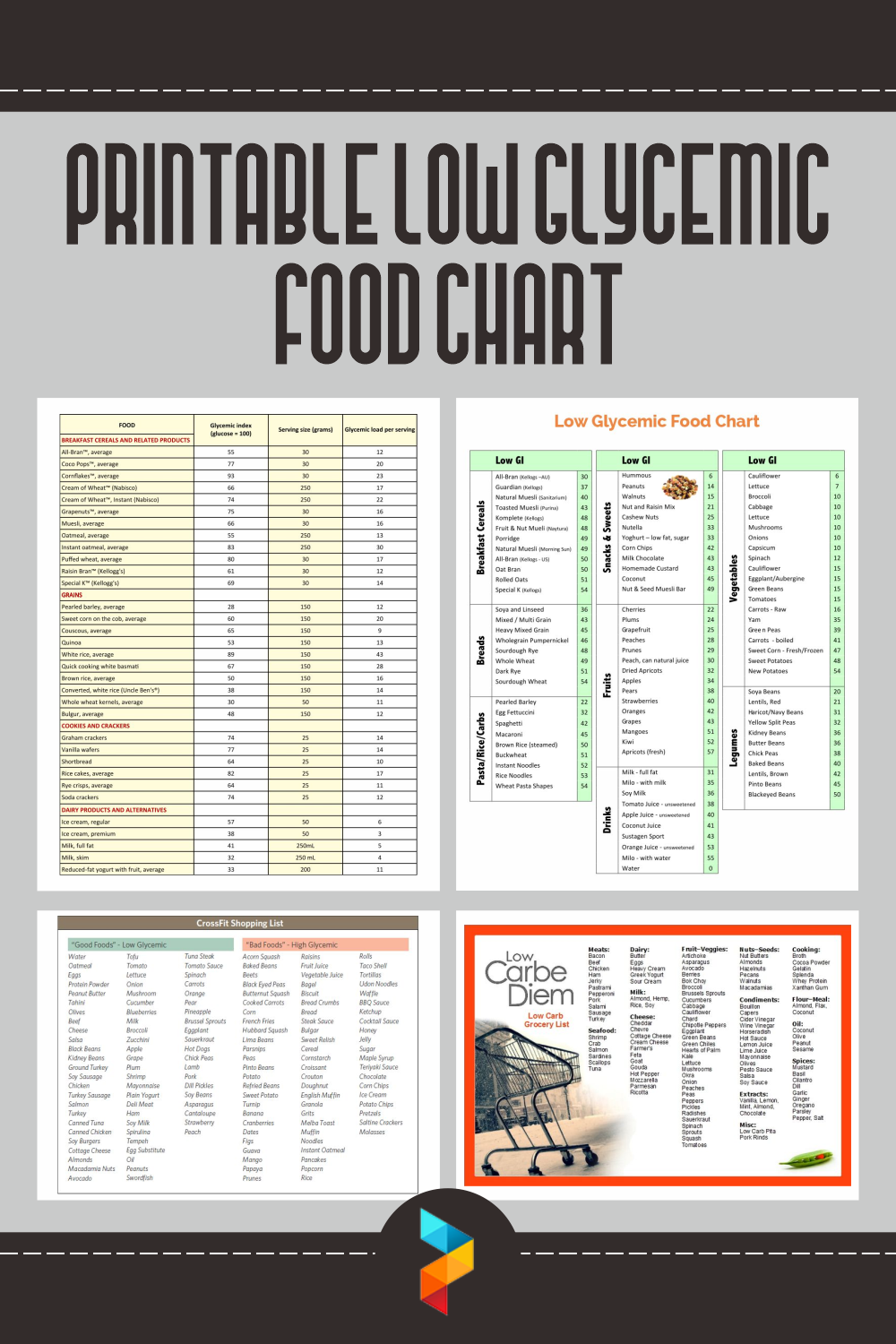Hello and welcome to this informative post all about the glycemic index! This chart is a great tool for understanding how different foods affect your blood sugar levels, which is especially important for those with diabetes or trying to manage their weight. So let’s dive right in and take a look at some of the best resources for learning about the glycemic index.
Glycemic Index Chart
 The first resource we have for you is this handy glycemic index chart. It provides a comprehensive list of foods and their respective glycemic index values, which range from 0 to 100, with 100 being the highest. Foods with a high glycemic index can cause a rapid spike in blood sugar levels, while low glycemic index foods are digested more slowly and cause a more gradual rise in blood sugar. This chart is a great reference tool for anyone looking to make healthier food choices and understand how the foods they eat impact their body.
The first resource we have for you is this handy glycemic index chart. It provides a comprehensive list of foods and their respective glycemic index values, which range from 0 to 100, with 100 being the highest. Foods with a high glycemic index can cause a rapid spike in blood sugar levels, while low glycemic index foods are digested more slowly and cause a more gradual rise in blood sugar. This chart is a great reference tool for anyone looking to make healthier food choices and understand how the foods they eat impact their body.
Low Glycemic Index Food List
 Another great resource for understanding the glycemic index is this printable low glycemic index food list. It breaks down foods into categories like fruits, vegetables, grains, and proteins, and gives examples of low glycemic index options in each category. This list can be a great starting point for anyone looking to make dietary changes to better manage their blood sugar levels.
Another great resource for understanding the glycemic index is this printable low glycemic index food list. It breaks down foods into categories like fruits, vegetables, grains, and proteins, and gives examples of low glycemic index options in each category. This list can be a great starting point for anyone looking to make dietary changes to better manage their blood sugar levels.
Glycemic Index Chart Templates
 If you’re looking for a more customizable glycemic index chart, these free templates in PDF, Word, and Excel formats are a great option. You can fill them in with the specific foods you eat or plan to eat, and track your progress over time. This can be a useful tool for those with diabetes or trying to lose weight who need to closely monitor their blood sugar levels.
If you’re looking for a more customizable glycemic index chart, these free templates in PDF, Word, and Excel formats are a great option. You can fill them in with the specific foods you eat or plan to eat, and track your progress over time. This can be a useful tool for those with diabetes or trying to lose weight who need to closely monitor their blood sugar levels.
Printable Glycemic Index Chart
 Another printable glycemic index chart option is this image search result. It breaks down foods into categories like high glycemic, medium glycemic, and low glycemic, and includes examples of each. This chart is a great visual tool for understanding the glycemic index and making informed dietary choices.
Another printable glycemic index chart option is this image search result. It breaks down foods into categories like high glycemic, medium glycemic, and low glycemic, and includes examples of each. This chart is a great visual tool for understanding the glycemic index and making informed dietary choices.
Glycemic Index Food List Printable
 If you prefer a more concise list of low glycemic index foods, this printable guide is a great option. It includes 50 different foods and their glycemic index values, as well as tips for creating balanced meals. This can be a useful tool for anyone looking to make healthier food choices or manage their blood sugar levels.
If you prefer a more concise list of low glycemic index foods, this printable guide is a great option. It includes 50 different foods and their glycemic index values, as well as tips for creating balanced meals. This can be a useful tool for anyone looking to make healthier food choices or manage their blood sugar levels.
Glycemic Index and Weight Loss
 One of the benefits of understanding the glycemic index is its potential for weight loss. Research has shown that following a low glycemic index diet can lead to decreased appetite, weight loss, and improved blood sugar control. This chart provides an overview of the glycemic index and how it can be used in conjunction with a healthy diet to achieve weight loss goals.
One of the benefits of understanding the glycemic index is its potential for weight loss. Research has shown that following a low glycemic index diet can lead to decreased appetite, weight loss, and improved blood sugar control. This chart provides an overview of the glycemic index and how it can be used in conjunction with a healthy diet to achieve weight loss goals.
Glycemic Index Chart PDF
 For those who prefer a more portable version of the glycemic index chart, this PDF option is a great resource. It can be saved to your smartphone or tablet for easy access while grocery shopping or meal planning. Plus, it includes a helpful legend for understanding the different glycemic index values.
For those who prefer a more portable version of the glycemic index chart, this PDF option is a great resource. It can be saved to your smartphone or tablet for easy access while grocery shopping or meal planning. Plus, it includes a helpful legend for understanding the different glycemic index values.
10 Best Printable Low Glycemic Food Chart
 This list of 10 different printable low glycemic food charts provides plenty of options for finding the right chart for your needs. From simple lists to more detailed charts with added nutrition information, these resources can be a helpful tool for understanding the glycemic index and making healthier food choices.
This list of 10 different printable low glycemic food charts provides plenty of options for finding the right chart for your needs. From simple lists to more detailed charts with added nutrition information, these resources can be a helpful tool for understanding the glycemic index and making healthier food choices.
GI of Food Chart Printable
 Another printable food chart option is this GI of food chart. It includes not only the glycemic index values of various foods, but also information about their glycemic load, which takes into account portion sizes. This can be a useful tool for anyone looking to more closely monitor their blood sugar levels.
Another printable food chart option is this GI of food chart. It includes not only the glycemic index values of various foods, but also information about their glycemic load, which takes into account portion sizes. This can be a useful tool for anyone looking to more closely monitor their blood sugar levels.
Low Glycemic Foods for Pregnancy
 Finally, this chart specifically focuses on low glycemic foods for pregnant women. It provides a list of foods that are not only low in glycemic index, but also high in important pregnancy nutrients like fiber, iron, and calcium. This can be a great resource for pregnant women looking to make informed dietary choices for both themselves and their growing baby.
Finally, this chart specifically focuses on low glycemic foods for pregnant women. It provides a list of foods that are not only low in glycemic index, but also high in important pregnancy nutrients like fiber, iron, and calcium. This can be a great resource for pregnant women looking to make informed dietary choices for both themselves and their growing baby.
We hope this post has provided you with a wealth of information and resources for understanding the glycemic index. Remember, making informed dietary choices and monitoring your blood sugar levels can make a huge difference in your overall health and wellbeing. Happy eating!